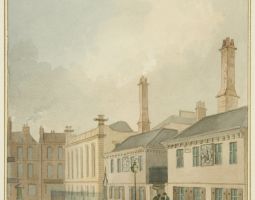From the beginning of the 16th century until the early 19th century, the Merchant Venturers Society managed Bristol’s harbour. During the 18th century, Bristol’s trade with Africa increased substantially, in particular through the ‘triangular trade’ whereby manufactured goods were shipped from Bristol to West Africa, where they were exchanged for slaves, who were shipped to the West Indies and exchanged for sugar, molasses and rum, which was brought back to Britain. In 1783 the Society rebuilt the Hall, transforming it into an elegant building in a modern style. It was destroyed by bombing during World War II. The Society then moved out of King Street to their present Hall in The Promenade, Clifton Down.
In 1803 the Docks Company was formed with the active involvement of the Merchant Venturers and Bristol Corporation. They were instrumental in creating the Floating Harbour in 1809 and the construction of many of Bristol’s industrial features, such as the Cumberland Basin, Bathurst Basin, the New Cut and various locks and bridges.
In 1832 the Society assisted in setting up the Great Western Railway Company. It also played a leading role in the creation of a number of major Bristol landmarks, including Clifton and Durdham Downs and the Clifton Suspension Bridge.
Abolitionist Thomas Clarkson, describing his investigation of the slave trade in Bristol, writes of using the Hall’s resources in his research: ‘I employed myself occasionally in the Merchants-hall, in making copies of the muster-rolls of ships sailing to different parts of the world, that I might make a comparative view of the loss of seaman in the slave trade, with that of those in the other trades from the same port.’ (1787

